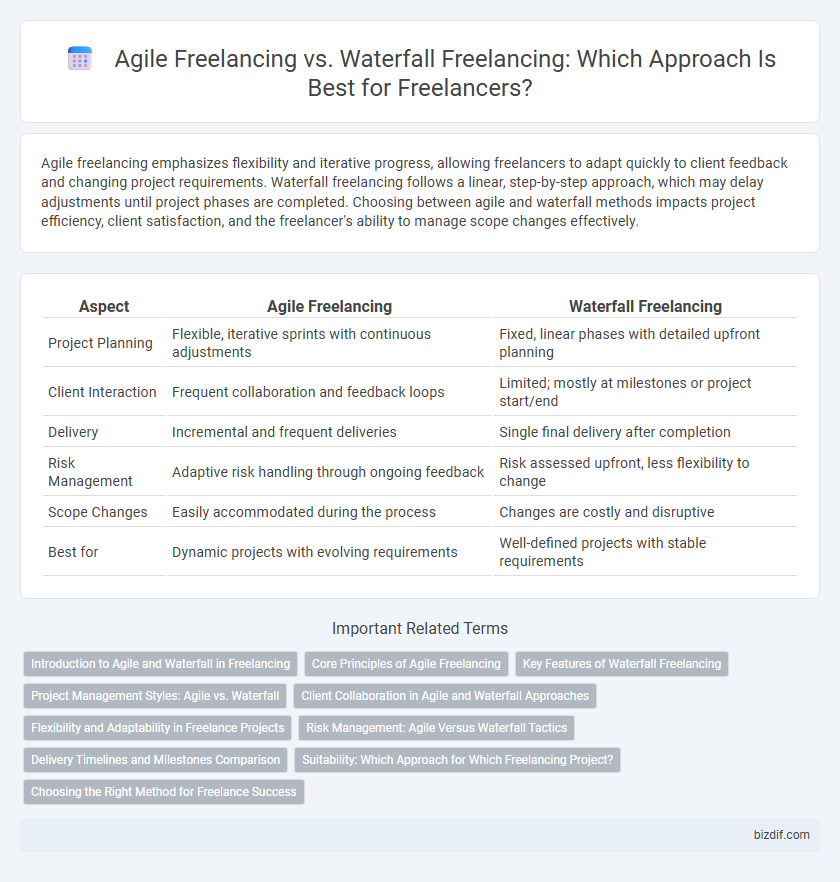Agile freelancing emphasizes flexibility and iterative progress, allowing freelancers to adapt quickly to client feedback and changing project requirements. Waterfall freelancing follows a linear, step-by-step approach, which may delay adjustments until project phases are completed. Choosing between agile and waterfall methods impacts project efficiency, client satisfaction, and the freelancer's ability to manage scope changes effectively.
Table of Comparison
| Aspect | Agile Freelancing | Waterfall Freelancing |
|---|---|---|
| Project Planning | Flexible, iterative sprints with continuous adjustments | Fixed, linear phases with detailed upfront planning |
| Client Interaction | Frequent collaboration and feedback loops | Limited; mostly at milestones or project start/end |
| Delivery | Incremental and frequent deliveries | Single final delivery after completion |
| Risk Management | Adaptive risk handling through ongoing feedback | Risk assessed upfront, less flexibility to change |
| Scope Changes | Easily accommodated during the process | Changes are costly and disruptive |
| Best for | Dynamic projects with evolving requirements | Well-defined projects with stable requirements |
Introduction to Agile and Waterfall in Freelancing
Agile freelancing emphasizes iterative development, continuous feedback, and flexibility, allowing freelancers to adapt quickly to client needs and project changes. Waterfall freelancing follows a linear, sequential approach where each phase, from planning to delivery, is completed before moving to the next, providing clear milestones and deliverables. Choosing between agile and waterfall methodologies depends on project complexity, client involvement, and the freelancer's preferred workflow for managing tasks and timelines.
Core Principles of Agile Freelancing
Agile freelancing centers on iterative progress, continuous feedback, and adapting to change, emphasizing collaboration between freelancer and client to deliver value incrementally. Core principles include maintaining transparency through regular communication, prioritizing client satisfaction by responding swiftly to evolving requirements, and promoting flexibility in project scope and timelines. This approach contrasts with waterfall freelancing's linear structure, allowing agile freelancers to enhance responsiveness and manage complex projects more efficiently.
Key Features of Waterfall Freelancing
Waterfall freelancing follows a linear and sequential project management approach where each phase, from requirements gathering to delivery, is completed before moving to the next. Key features include fixed project scope, clearly defined deliverables, and minimal client interaction during the execution phase, ensuring predictability and strict adherence to deadlines. This method suits projects with well-understood requirements and limited need for changes.
Project Management Styles: Agile vs. Waterfall
Agile freelancing emphasizes iterative development, continuous feedback, and adaptability, enabling freelancers to respond quickly to changing client requirements for enhanced project outcomes. Waterfall freelancing follows a linear, sequential project management style where each phase--planning, design, execution, and delivery--must be completed before moving to the next, ensuring clear milestones but limiting flexibility. Choosing between agile and waterfall approaches depends on project complexity, client collaboration preferences, and the need for rapid adjustments versus structured deliverables.
Client Collaboration in Agile and Waterfall Approaches
Client collaboration in agile freelancing emphasizes continuous communication and iterative feedback, allowing freelancers to adapt to changing client needs quickly and improve project outcomes. In contrast, waterfall freelancing follows a linear process with defined stages, limiting client interaction mostly to project initiation and final delivery, which can reduce flexibility but provide clear milestones. Agile's collaborative approach fosters stronger client relationships and responsiveness, while waterfall's structure ensures predictable timelines and deliverables.
Flexibility and Adaptability in Freelance Projects
Agile freelancing emphasizes flexibility and adaptability by allowing freelancers to respond quickly to client feedback and evolving project requirements, fostering continuous improvement throughout the project lifecycle. In contrast, waterfall freelancing follows a linear, sequential approach that limits changes once a project phase is completed, reducing agility in addressing unforeseen challenges. Embracing agile methods enhances project outcomes by promoting iterative development and collaboration between freelancers and clients, ensuring deliverables remain aligned with dynamic goals.
Risk Management: Agile Versus Waterfall Tactics
Agile freelancing emphasizes iterative progress and continuous feedback, enabling freelancers to identify and mitigate risks early in the project lifecycle. Waterfall freelancing, characterized by linear phases and rigid planning, often delays risk detection until later stages, increasing potential for costly revisions. Effective risk management in agile freelancing relies on adaptability and frequent reassessment, contrasting with the predictability and fixed scope inherent in waterfall methods.
Delivery Timelines and Milestones Comparison
Agile freelancing emphasizes flexible delivery timelines with iterative milestones, allowing continuous revisions and faster adjustments to client feedback throughout the project lifecycle. Waterfall freelancing follows a linear delivery timeline with fixed milestones, where each phase must be completed before the next begins, leading to more rigid schedules and delayed final deliveries. Agile methods typically result in shorter delivery cycles and more frequent updates, whereas Waterfall provides clear, predefined deadlines and milestone checkpoints.
Suitability: Which Approach for Which Freelancing Project?
Agile freelancing suits projects requiring flexibility, frequent client feedback, and iterative progress, such as software development or digital marketing campaigns. Waterfall freelancing is ideal for well-defined projects with clear scope and deliverables, like website design or content creation with fixed deadlines. Matching the approach to project complexity and client involvement ensures timely delivery and quality outcomes.
Choosing the Right Method for Freelance Success
Agile freelancing emphasizes flexibility, iterative progress, and constant client collaboration, making it ideal for projects with evolving requirements or creative uncertainty. Waterfall freelancing follows a linear, structured approach with clearly defined phases, suiting projects with fixed scopes and deadlines. Selecting the right method depends on project complexity, client engagement level, and the freelancer's adaptability to change, ensuring optimal productivity and client satisfaction.
agile freelancing vs waterfall freelancing Infographic

 bizdif.com
bizdif.com